
Pictorialism is an international style and aesthetic movement that dominated photography during the later 19th and early 20th centuries. There is no standard definition of the term, but in general it refers to a style in which the photographer has somehow manipulated what would otherwise be a straightforward photograph as a means of creating an image rather than simply recording it. Typically, a pictorial photograph appears to lack a sharp focus, is printed in one or more colors other than black-and-white and may have visible brush strokes or other manipulation of the surface. For the pictorialist, a photograph, like a painting, drawing or engraving, was a way of projecting an emotional intent into the viewer's realm of imagination.

Alfred Stieglitz was an American photographer and modern art promoter who was instrumental over his 50-year career in making photography an accepted art form. In addition to his photography, Stieglitz was known for the New York art galleries that he ran in the early part of the 20th century, where he introduced many avant-garde European artists to the U.S. He was married to painter Georgia O'Keeffe.
291 is the commonly known name for an internationally famous art gallery that was located in Midtown Manhattan at 291 Fifth Avenue in New York City from 1905 to 1917. Originally called the "Little Galleries of the Photo-Secession", the gallery was established and managed by photographer Alfred Stieglitz.

Gertrude Käsebier was an American photographer. She was known for her images of motherhood, her portraits of Native Americans, and her promotion of photography as a career for women.

Clarence Hudson White was an American photographer, teacher and a founding member of the Photo-Secession movement. He grew up in small towns in Ohio, where his primary influences were his family and the social life of rural America. After visiting the World's Columbian Exposition in Chicago in 1893, he took up photography. Although he was completely self-taught in the medium, within a few years he was internationally known for his pictorial photographs that captured the spirit and sentimentality of America in the early twentieth century. As he became well known for his images, White was sought out by other photographers who often traveled to Ohio to learn from him. He became friends with Alfred Stieglitz and helped advance the cause of photography as a true art form. In 1906 White and his family moved to New York City in order to be closer to Stieglitz and his circle and to further promote his own work. While there he became interested in teaching photography and in 1914 he established the Clarence H. White School of Photography, the first educational institution in America to teach photography as art. Due to the demands of his teaching duties, his own photography declined and White produced little new work during the last decade of his life. In 1925 he suffered a heart attack and died while teaching students in Mexico City.

Anne Wardrope Brigman was an American photographer and one of the original members of the Photo-Secession movement in America.
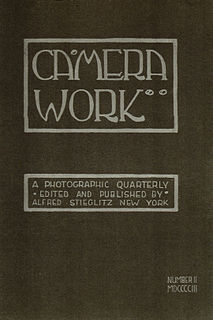
Camera Work was a quarterly photographic journal published by Alfred Stieglitz from 1903 to 1917. It is known for its many high-quality photogravures by some of the most important photographers in the world and its editorial purpose to establish photography as a fine art. It has been called "consummately intellectual", "by far the most beautiful of all photographic magazines", and "a portrait of an age [in which] the artistic sensibility of the nineteenth century was transformed into the artistic awareness of the present day."
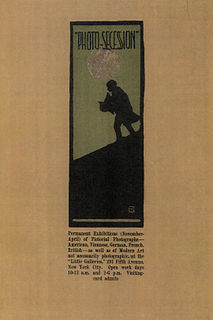
The Photo-Secession was an early 20th century movement that promoted photography as a fine art in general and photographic pictorialism in particular.
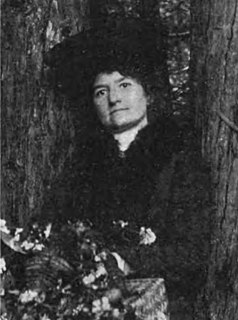
Adelaide Hanscom Leeson was an early 20th-century artist and photographer who published some of the first books using photography to illustrate literary works.
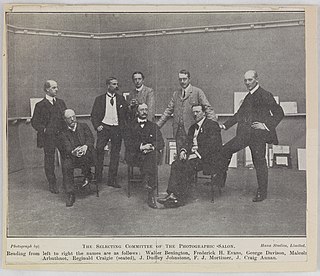
The Linked Ring was a British photographic society created to propose and defend that photography was just as much an art as it was a science, motivated to propelling photography further into the fine art world. Members dedicated to the craft looked for new techniques that would cause the less knowledgeable to steer away, persuading photographers and enthusiasts to experiment with chemical processes, printing techniques and new styles.

Robert Demachy (1859–1936) was a prominent French Pictorial photographer of the late 19th and early 20th century. He is best known for his intensely manipulated prints that display a distinct painterly quality.
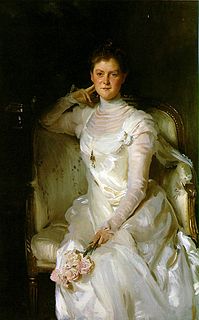
Sarah Choate Sears (1858–1935) was an American art collector, art patron, cultural entrepreneur, artist and photographer.

Eva Watson-Schütze (1867–1935) was an American photographer who was one of the founding members of the Photo-Secession.

Frank Eugene was an American-born photographer who was a founding member of the Photo-Secession and one of the first university-level professors of photography in the world.
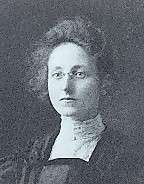
Myra Albert Wiggins (1869–1956) was an American painter and pictorial photographer who became a member of the important early 20th century Photo-Secession movement.

Camera Notes was a photographic journal published by the Camera Club of New York from 1897 to 1903. It was edited for most of that time by photographer Alfred Stieglitz and was considered the most significant American photography journal of its time. It is valuable today both as a record of photographic aesthetics of the time and for its many high-quality photogravures by photographers such as Stieglitz, James Craig Annan, F. Holland Day, Robert Demachy, Frances Benjamin Johnston, Gertrude Kasebier and Clarence H. White.

Harriet Candace "Rose" Clark (1852–1942) was an early 20th-century American painter and pictorial photographer. She is best known for the photographs she exhibited with Elizabeth Flint Wade under their joint names, either as "Rose Clark and Elizabeth Flint Wade" or as "Misses Clark and Wade".

Joseph Turner Keiley was an early 20th-century photographer, writer and art critic. He was a close associate of photographer Alfred Stieglitz and was one of the founding members of the Photo-Secession. Over the course of his life Keiley's photographs were exhibited in more than two dozen international exhibitions, and he achieved international acclaim for both his artistic style and his writing.

James Craig Annan was a pioneering Scottish-born photographer and Honorary Fellow of the Royal Photographic Society.
Thomas O’Conor Sloane, Jr. (1879–1963) was an American photographer. Sloane was born in 1879 in Brooklyn, New York but spent much of his adult life in South Orange, New Jersey. Sloane was already photographing by the summer of 1894, when he photographically documented a week-long cruise with his father on a sloop yacht on Long Island Sound. Pictures of this trip survive in an album he compiled that is now at the Mystic Seaport Museum, Mystic, Connecticut. Sloane was most active as a naturalistic photographer at the turn of the twentieth century, garnering acclaim for his gum bichromate work. In Sloane's early twenties, he focused primarily on portraiture, becoming a professional sometime thereafter and remaining active until the 1940s, when a diving accident severely impaired his eyesight. Sloane experimented with gum bichromate, platinum, pigment, gaslight and gelatin silver prints and various lenses.



















